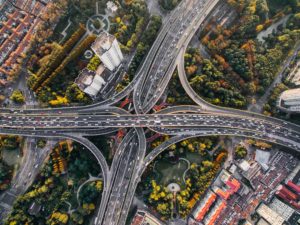Innovative Applications in Geospatial Analytics
Since Charles Piquet and John Snow first applied the concept of spatial analysis to maps of cholera outbreaks in 19th century Europe, analysis of geographic location data has become a huge industry. Today’s technologies are accelerating innovative analysis and providing solutions to problems in multiple sectors like agriculture, environmental monitoring and supply-chain tracking. In this article, we will explore some of the key features of today’s geospatial analytics market, and where to look for future innovation.

The attractiveness of the geospatial analytics market – shifting supply & demand
A survey of market forecasts indicates the current size of the geospatial analytics market is somewhere between $35 billion and $40 billion, with forward looking 5-year CAGR of 14 to 17%.
High quality, high frequency imagery for monitoring the globe has been expensive, hard to analyze, and most of demand came from governments and the military. This is no longer the case – smaller, smarter satellites are being launched more frequently (and more cheaply!) than ever before, greatly expanding access to data. The incumbent players like Maxar Technologies’ geospatial analytics arm, Radiant Solutions, get around 90% of their $300 million annual revenue from US military and government contracts. Taking advantage of increased access to data, new companies have emerged in this sector over the past half-decade – raising hundreds of millions of VC dollars in the process – and geospatial analytics is being used in an increasing array of non-government applications.
One example of new commercial users of geospatial analytics are financial firms, such as hedge funds, who see the clear value proposition in gaining quicker access to information regarding macro-economic changes and how they affect prices. The focus of hedge funds and traders naturally spans across multiple industries, something which was incredibly hard to analyze at scale via previously used methods (e.g. counting ships entering/leaving a port, trains with cargo etc.), but is now made easy via algorithmic functions run over various types of satellite data.
Turning satellite data into actionable forecasts on market fluctuations can give traders the edge, and as such, there are several geospatial analytics firms focusing initially on this deep-pocketed market segment. Geospatial analytics startups such as Orbital Insight, Ursa Space, and SpaceKnow have all begun by targeting financial firms, deepening their understanding of product needs in this sector, before looking to expand into other closely aligned verticals.
Algorithmically complex systems can now be built and run on a standard consumer laptop, accessing imagery via the cloud. This dynamic is creating a shift to relatively asset-light geospatial analytics companies, meaning there are low barriers to market entry. To protect their share of the market, geospatial analytics players are beginning to look for defensibility through diversification of their product while developing a greater degree of understanding of the fundamental cross-sectoral drivers that affect current and new clients’ markets.
What next?
The frequency relay of satellite images has gone from a monthly to a daily occurrence over the past decade, and soon it will become an hourly temporal cadence. This shift will enable further opportunities in applying machine learning and AI algorithms to these data sets, with new use cases and applications.
Moving beyond the satellite data to incorporate data from the proliferation of inexpensive terrestrial sensors (IoT) adds even more opportunity. The Chinese city of Nanjing’s Intelligent Transport Systems (ITS) combines sensor, camera and geospatial data to analyze traffic movement in real time to reduce congestion. When this functionality is coupled with other uses of geospatial analytics, such as monitoring of construction rates or supply chain dynamics, we move towards a truly integrated smart city, utilizing data in a macroscopic way to streamline many different industrial activities.

Augmented/virtual reality (AR or VR) is another area were geospatial technologies can have a future impact. AR technology superimposes digital information on whatever you’re looking at through your phone or headset, combining several different sets of data to provide information. In a commercial setting, geospatial analytics could combine with AR to bring incredible amounts of location-centric information to our fingertips in an intuitive way. For example, AR devices could provide real time location-centric mapping which provides information on streets, buildings, prices, occupancy and almost any other information set. By cross-referencing satellite imagery and analytics with AR technologies, construction, surveying, asset maintenance and many other industrial activities will become much more effective and time efficient.

There are far too many future applications of geospatial analytics to dive into within this article, but activities from biosecurity and health informatics, urban planning, and even sociological research will all be impacted by our ability to view in real-time how the earth and everything around us changes. Stay tuned.


